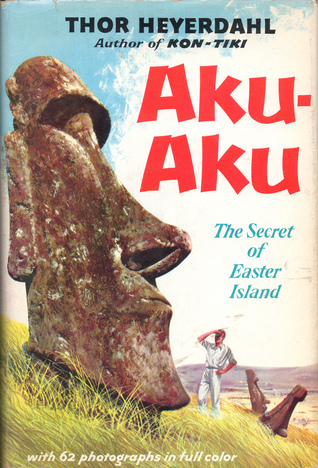Near the end of "Aku-Aku," one of the archeologists working with Thor
Heyerdahl admits to being astonished at yet another unexpected turn of
events.
"I never knew archeology could produce so many surprises," he says.
Indeed, anyone who thinks that archeology is just about digging in the dirt will be surprised – pleasantly – by "Aku-Aku."
In
this account of his 1955-56 expedition to Easter Island and other
Polynesian islands, Heyerdahl presents a series of mysteries: Where did
the great stone statues on Easter Island come from? Who made them? How
did the makers move them? Where are the hidden caves of Easter Island and what
secrets do they hold?
Heyerdahl is not a great writer, but he is
usually good enough. His weakness lies in portraying people; even the
most prominent character of the book – Easter Island's mayor – comes
off as just a simplistic caricature. An odd quirk of the author is that
he refers to some characters almost solely by their jobs – "the
photographer," "the skipper," "the doctor." After awhile you begin to
wonder if these people have names.
But Heyerdahl is passionate
about his work and his enthusiam shows as he presents – and, mostly,
solves – mystery after mystery. He is relentless, for instance, in
trying to get the natives to reveal their secret caves, even when it
means he has to eat a chicken tail, strip to his underwear, and climb
down a sheer cliff without a rope.
(The caves are a curious form
of secure storage on this island that seems to lack locks. Note to self:
Open self-storage franchise on Easter Island.)
A couple ethical
issues occur to me, although I can't claim to have the whole picture
from just one book. Did Heyerdahl adequately reward the islanders for
the artifacts they gave him? He mentions some gifts but it's unclear
whether all of them received something and how much. Also, he resorts to
some trickery to get the natives to give him things – is this fair?
(I'm sure Heyerdahl would argue that he had to immerse himself in the
natives' world of superstition and ghosts to communicate with them
successfully.)
The bulk of the book is about Easter Island but
the last two chapters discuss the expedition's visits to other islands.
The story of the dig on Rapa Iti is particularly good, and I would have
enjoyed a bit more on these other islands.
---
(Please support this blog by clicking on an ad, or by donating via the
Paypal button below.)

No comments:
Post a Comment